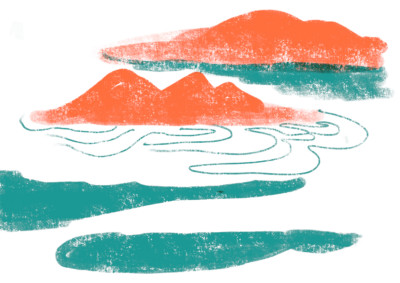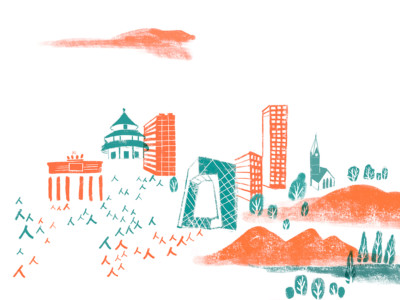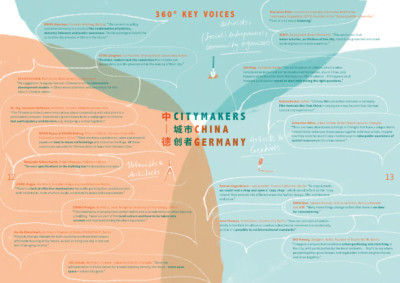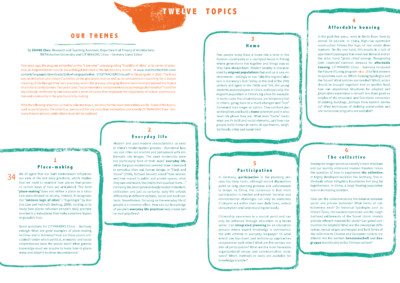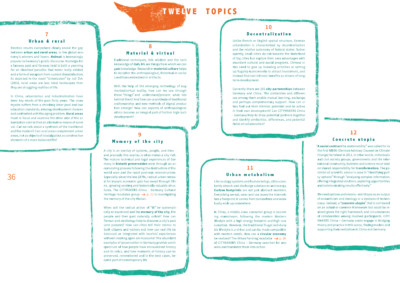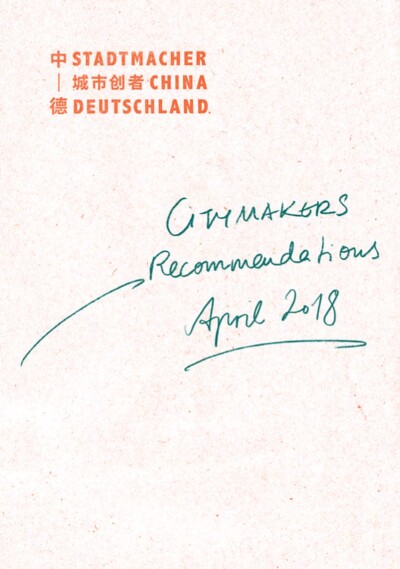Two years ago, the program embarked on the “citymaker” concept putting “livability of cities” at its center of attention, as Katja Hellkötter and Dr. Eduard Kögel indicated in the introductory article to the program in 2016. The focus was on initiatives and citizens’ activities at the grassroots level as well as on entrepreneurs searching for a deeper meaning of life through their own practices, and in the process, changing the micro environment beyond the impact of architects and planners. Two years later, “social innovation complementary to technological innovation” is still the key concept, reinforced by interviews with a series of voices that emphasize the importance of culture, communication and community in the practice of city making. With the following reflection on twelve selected topics, we describe the most relevant key words. Some of the topics, such as participation, the collective, memory of the city and urban metabolism, are already CITYMAKERS China – Germany feature articles, while others must still be explored.
1. Place-making
We all agree that our built environment influences our view of life and daily practices, which implies that we need to examine how places that produce certain ways of lives are articulated. The term “place-making” does not define a place as a structure subordinated to society. Instead, it recognizes the “intrinsic logic of cities” (“Eigenlogik” by Martina Löw and Helmuth Berking, 2008), inviting us to study how places influence people’s daily practice in order to create places that make a positive impact on people’s lives. Some questions for CITYMAKERS China – Germany emerge: What are good examples of place-making in China and in Germany? How are these places articulated? Under which political, economic and social circumstances were the places born? What general knowledge must we acquire to learn how to place-make and adapt it to other circumstances?
2. Everyday life
Modern and post-modern characteristics co-exist in China’s modernization process – functional houses and cities are erected and juxtaposed with emblematic city images. The sleek modernists were not particularly fond of their users’ everyday life, while the post-modernists seemed more interested in semiotics than real human beings. In “Flesh and Stone”(1996), Richard Sennett asked “how women and men moved in public and private spaces, what they saw and heard, the smells that assailed them…” Certainly the description is deeply rooted in Western civilization and just as certainly, daily life unfolds differently in different cultural, social and built contexts. Nevertheless, focusing on the everyday life of people is a common effort. How can our knowledge of people’s everyday life practices help create better everyday lives?
3. Home
Few people today have a home like a farm in the German countryside or a courtyard house in Peking where generations live together and things stay as they have always been. Modern society is characterized by migrant populations that end up in new environments, willingly or not. Take the migrant laborers in Germany’s Ruhr Valley at the end of the 19th century and again in the 1960s and ’70s, the young students and employees in cities, and especially, the migrant population in China’s big cities for example. In some cases the circumstances are temporary but in others, going back to a much changed and “lost” homeland is no longer an option. They confront pre- sent realities and build a home wherever and in whatever life phase they are. What does “home” mean, what are its built and social elements, and how can people build homes in terms of apartments, neighborhoods, cities and social ties?
4. Affordable housing
In the past five years, rents in Berlin have risen by almost 30 percent. In China, high-rise apartment construction follows the logic of real estate development. On the one hand, this results in a lack of apartment typologies that meet real demand and on the other hand“, ghost cities” emerge. Recognizing both countries’ common demand for affordable housing, CITYMAKERS China – Germany incubated the Future of Living focus group p. 18 to find answers to questions such as: Which housing typologies suit the future? What policies are needed? Which actors should be brought together? And on another level, how can abandoned structures be adapted and ghost cities experience a revival? Are there good examples of the structural and functional conversion of existing buildings, perhaps from eastern Germany? What techniques of building preservation and use conversion programs are available?
5. Participation
In Germany, participation in the planning process has deep roots, although recent discussions point to long planning process and unforeseeable delays. In China, the consensus is that more participation is needed and wanted. Societal and environmental challenges can only be overcome if citizens act within their own daily lives, reduce consumption and take recycling seriously. Citizenship awareness is a crucial point and can only be achieved through education in a broad sense. Can integrated planning be an education process where expert knowledge is communicated with citizens in everyday language? To what extent can top-down and bottom-up approaches complement each other? What are the various models of participation? What are the most favorable organizational setups and communication structures? Which methods or tools are available for knowledge transfer?
6. The collective
Kinship no longer serves as society’s main structure and our warmly embraced modern freedom raises the question of how to regenerate the collective. In highly developed societies like Germany, free individuals refuse obligatory boundaries but long for togetherness. In China, a large floating population lives in increasing isolation. How can the collective revive the balance between social and private demands? What forms of collectiveness exist? Do historical typologies such as China’s Tulou, the socialist commune and the neighborhood settlements of the Soviet Union models provide relevant material for study? Can gated com- munities be adapted? What are the conceptual differences, lexical origin, archetypes and built forms of the collective in Chinese and European cultural traditions? Are the German Genossenschaft and Baugruppe transferable to the Chinese context?
7. Urban & rural
Election results everywhere clearly reveal the gap between urban and rural areas, or the global economy’s winners and losers. Heimat is increasingly popular in Germany’s public discourse. Nostalgia for a faraway past and faraway land is both a yearning for an idealized paradise that never really existed and a form of escapism from current dissatisfaction. As depicted in the novel “Unterleuten” by Juli Zeh (2016), rural areas are less ideal landscapes than they are struggling realities of life. In China, urbanization and industrialization have been key words of the past forty years. The countryside suffers from a shrinking labor pool and low education standards, missing development chances and confronted with the aging problem. Rural areas must re-focus and examine the other side of the urbanization coin to find an alternative means of survival. Can we talk about a synthesis of the traditional and the modern? Can rural areas complement urban areas, not as objects of nostalgia but as constructive elements of a more balanced life?
8. Material & virtual
Traditional techniques, folk wisdom and the tacit knowledge of daily life are things from which we can gain knowledge. Research in material culture helps to decipher the anthropological, historical or social conditions embedded in artifacts. With the help of the emerging technology of augmented/virtual reality, how can we see through these “things” and understand/present what lies behind them? And how can a synthesis of traditional craftsmanship and new methods of digital production emerge? How can aspects of anthropological ethics become an integral part of further high-tech development?
9. Memory of the City
A city is an overlay of systems, people, and time – and precisely this overlay is what makes a city rich. The mature technical and legal experiences of Germany in historic preservation went through an accumulating process following the destruction of the world wars and the rapid post-war reconstruction. Especially since the late 1970s, radical urban renew- al for myopic economic gain has swept through China, ignoring existing and historically valuable structures. The CITYMAKERS China – Germany Cultural Heritage incubator group p. 22 is investigating the memory of the city Wuhan. When will the radical action of “拆” be systematically re-examined and the memory of the city, the people and their past naturally unfold? How can flaneur and strollology help to discover a city’s past (and present)? How can cities tell their stories to both citizens and visitors and how can real life be balanced or integrated with tourists’ experiences without creating open-air museums? The abundant examples of preservation in Germany provide a rich spectrum of how people have encountered history and its relics, and how moments of history can be preserved, remembered and in the best cases, become part of contemporary life.
10. Decentralization
Unlike French or English spatial structure, German urbanization is characterized by decentralization and the relative autonomy of federal states. Subsequently, small cities do not become the hinterland of big cities but explore their own advantages with abundant cultural and social programs. Chinese cities need to give up branding activities or setting up flagship icons merely to attract investment, and instead find real intrinsic benefits as drivers of long-term development. Currently there are 105 city partnerships between Germany and China. The similarities and differences among them enable mutual learning, exchange, and perhaps complementary support. How can cities find out their intrinsic potential and be active in their own development? Can CITYMAKERS China – Germany help to draw potential partners together and identify similarities, differences, and potential fields of collaboration?
11. Urban metabolism
Like ecology systems and human beings, cities constantly absorb and discharge substances and energy. Carbon footprints are not just abstract numbers. Everything we eat, wear and use (even the internet) has a footprint: it comes from somewhere and eventually ends up somewhere. In China, a middle-class consumer group is becoming mainstream, following the modern Western lifestyle with a high energy footprint and high consumption. However, the traditional frugal and durable lifestyle is a virtue and can be made compatible with modern needs. How can a circular economy be realized? The Urban Farming incubator p. 26 of CITYMAKERS China – Germany searches for answers and translates them into action.
12. Concrete utopia
“A social contract for sustainability” was called for in the first WBGU (German advisory Counsel on Climate Change) factsheet in 2011. In other words, individuals and civil society groups, governments and the international community, business and science must take on shared responsibility for transformation. The potential of scientific advice is seen in “identifying policy options” through “analyzing complex information, offering integrated solutions, exploring opportunities and communicating results effectively.” We need options and visions – not utopia as an output of romanticism and ideology or a dystopia of technocracy. Instead, a “concrete utopia” that is not based on an actual or common framework but could be realized given the right framework and circumstances of collaboration among involved participants. CITYMAKERS China – Germany could engage in bridging theory and practice in this sense, finding models and supporting their realization in China and Germany.
ZHANG Zhen
Sie ist wissenschaftliche Mitarbeiterin am Lehr- und Forschungsgebiet Architekturtheorie an der RWTH Aachen und ist Gastautorin für CITYMAKERS. Als Kuratorin der Ausstellung “Planetary Urbanism – the Transformative Power of Cities” im Deutschen Pavillon hat sie an der UN-Habitat III Konferenz in Quito, Ecuador, teilgenommen. Für ihrer Masterarbeit „Isle of Islay – Nature Observatory – Remembrance of a Forgotten Treaty between Man and Nature“ hat sie die besondere Auszeichnung zum BDA-SARP-Award erhalten und wurde für den Euregional Preis (EAP) nominiert. 2011-2013 war sie als Architektin bei von Gerkan, Marg und Partner Shanghai tätig. Als Architektin und internationale Projektkoordinatorin hat sie das Deutsch-Chinesische Haus auf der Weltausstellung 2010 in Shanghai mitrealisiert.
Email
